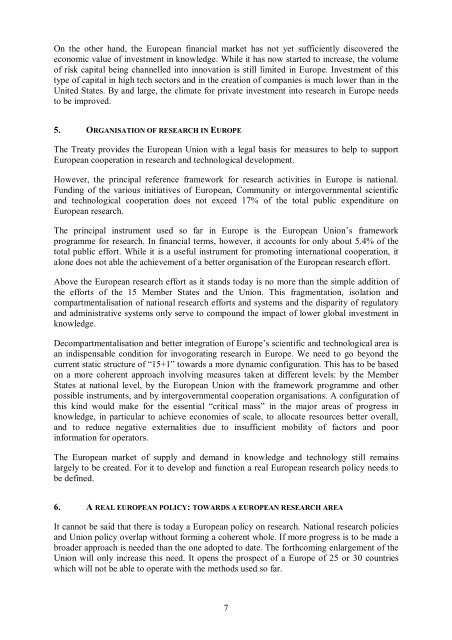(2000) 6 - EUR-Lex
(2000) 6 - EUR-Lex
(2000) 6 - EUR-Lex
You also want an ePaper? Increase the reach of your titles
YUMPU automatically turns print PDFs into web optimized ePapers that Google loves.
On the other hand, the European financial market has not yet sufficiently discovered theeconomic value of investment in knowledge. While it has now started to increase, the volumeof risk capital being channelled into innovation is still limited in Europe. Investment of thistype of capital in high tech sectors and in the creation of companies is much lower than in theUnited States. By and large, the climate for private investment into research in Europe needsto be improved.5. ORGANISATION OF RESEARCH IN <strong>EUR</strong>OPEThe Treaty provides the European Union with a legal basis for measures to help to supportEuropean cooperation in research and technological development.However, the principal reference framework for research activities in Europe is national.Funding of the various initiatives of European, Community or intergovernmental scientificand technological cooperation does not exceed 17% of the total public expenditure onEuropean research.The principal instrument used so far in Europe is the European Union’s frameworkprogramme for research. In financial terms, however, it accounts for only about 5.4% of thetotal public effort. While it is a useful instrument for promoting international cooperation, italone does not able the achievement of a better organisation of the European research effort.Above the European research effort as it stands today is no more than the simple addition ofthe efforts of the 15 Member States and the Union. This fragmentation, isolation andcompartmentalisation of national research efforts and systems and the disparity of regulatoryand administrative systems only serve to compound the impact of lower global investment inknowledge.Decompartmentalisation and better integration of Europe’s scientific and technological area isan indispensable condition for invogorating research in Europe. We need to go beyond thecurrent static structure of “15+1” towards a more dynamic configuration. This has to be basedon a more coherent approach involving measures taken at different levels: by the MemberStates at national level, by the European Union with the framework programme and otherpossible instruments, and by intergovernmental cooperation organisations. A configuration ofthis kind would make for the essential “critical mass” in the major areas of progress inknowledge, in particular to achieve economies of scale, to allocate resources better overall,and to reduce negative externalities due to insufficient mobility of factors and poorinformation for operators.The European market of supply and demand in knowledge and technology still remainslargely to be created. For it to develop and function a real European research policy needs tobe defined.6. A REAL <strong>EUR</strong>OPEAN POLICY: TOWARDS A <strong>EUR</strong>OPEAN RESEARCH AREAIt cannot be said that there is today a European policy on research. National research policiesand Union policy overlap without forming a coherent whole. If more progress is to be made abroader approach is needed than the one adopted to date. The forthcoming enlargement of theUnion will only increase this need. It opens the prospect of a Europe of 25 or 30 countrieswhich will not be able to operate with the methods used so far.7
















